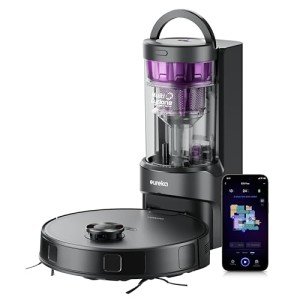Why People Don't Care About Cleaning Robots
Revolutionizing Home Maintenance: The Rise of Cleaning Robots
In an age where innovation continues to affect daily life, cleaning robots have emerged as a considerable development in the field of domestic cleaning. These autonomously functioning machines have redefined how families manage cleaning tasks, offering benefit and performance. With their capability to browse spaces, prevent barriers, and run on pre-set schedules, cleaning robots are becoming important tools for house owners seeking to optimize both their time and their living environment.
The Evolution of Cleaning Robots
Cleaning robots have actually gone through an incredible improvement given that their inception. What started as fundamental makers has actually progressed into sophisticated gadgets geared up with advanced functions. Below is a table highlighting some key milestones in the development of cleaning robots.
Year
Turning point
Description
1996
First Commercial Robot
The first robotic vacuum, Electrolux's Trilobite, was introduced.
2002
Roomba Launch
iRobot launched the Roomba, making robotic vacuum cleaners popular.
2004
Mapping Technology Introduced
iRobot presented smarter navigation abilities, permitting much better cleaning courses.
2012
Smartphone Integration
The intro of mobile app control allowed users to control robots from another location.
2020
Advanced Sensors & & AI
Robots began using AI for boosted mapping and things recognition.
Types of Cleaning Robots
As technology has advanced, numerous types of cleaning robots have surfaced, each designed to deal with different cleaning needs. A few of these consist of:
Robotic Vacuums
- Developed to autonomously vacuum floors, they often feature sensors to browse around spaces and return to their charging stations.
Robotic Mops
- These robots are geared up with mopping functionality, using water or cleaning solutions to scrub floorings.
Window Cleaning Robots
- Specifically engineered for window cleaning, these gadgets can climb vertical surface areas utilizing suction or magnetic systems.
Swimming Pool Cleaning Robots
- Designed for in-ground swimming pools, these robots collect particles and even scrub the walls of the swimming pool effectively.
Multi-tasking Robots
- Some contemporary cleaning robots integrate vacuuming and mopping capabilities, using flexible cleaning solutions.
How Cleaning Robots Work
The core performance of cleaning robots is focused around their ability to browse homes autonomously while carrying out cleaning jobs. Here's a breakdown of the fundamental components that allow them to perform successfully:
Sensors: Most cleaning robots are equipped with sensors that help them identify obstacles, slopes, and edges, preventing falls and collisions.
Navigation Technology: Many robots utilize a combination of gyroscopes, accelerometers, and often cams or LIDAR for navigation. This enables them to map their environment and clean effectively without missing out on spots.
Source of power: Most cleaning robots operate on rechargeable batteries, with many efficient in going back to their charging docks when their power runs low.
Cleaning Mechanisms: Whether through suction for vacuuming or rotating brushes for mopping, cleaning robots feature different mechanisms tailored for effective dirt elimination.
Advantages of Cleaning Robots
The incorporation of cleaning robots in homes presents numerous benefits:
Time-Saving: Cleaning robots can operate on their own, enabling property owners to participate in other activities.
Constant Cleaning: With arranged cleaning times, these robots guarantee constant upkeep of the home.
Hard-to-Reach Areas: Cleaning robots can access narrow spaces and corners that traditional cleaning tools may fight with.
Lowered Allergens: Regular cleaning assists lessen dust and irritants, adding to a much healthier living environment.
Limitations of Cleaning Robots
Regardless of their numerous benefits, cleaning robots likewise present certain restrictions that users should consider:
High Initial Cost: While the price of cleaning robots has actually decreased gradually, some sophisticated designs can be fairly pricey.
Irregular Performance: Not all robots carry out similarly; some might have a hard time with specific surfaces or dirt types, leading to unacceptable outcomes.
Minimal Capacity: Many robotic vacuums have smaller sized dustbin capacities, needing more regular emptying than traditional vacuum cleaners.
Frequently Asked Questions about Cleaning Robots
Q: Are cleaning robots worth the investment?A: Cleaning robots can be
a beneficial investment for those seeking time-saving services. They can significantly relieve the cleaning problem, especially for hectic households. Q: Can cleaning robots be programmed?A: Yes, numerous cleaning robots feature programmable schedules and modes, enabling users to set specific cleaning times and areas. Q: How do I maintain my cleaning robot?A: Regular upkeep involves cleaning the brushes, emptying the dustbin, and occasionally inspecting for software updates. Q: Are cleaning robots effective on all surfaces?A: Most robotic vacuums work on difficult floorings and low-pile carpets. However, effectiveness may
differ on thick carpets or specific kinds of carpets. Q: Do cleaning robots work well under furniture?A: Cleaning robots are developed to fit under most furniture; nevertheless, the efficiency can depend on the height of the furnishings.
**Cleaning robots represent an advancement in the realm of
domestic chores, using a blend of innovation, convenience, and efficiency. While they are not a complete replacement for standard
cleaning methods, they considerably improve housekeeping capabilities. As developments continue, future iterations of these devices are expected to become much more intelligent, efficient, and easy to use, additional integrating into the smart homes of tomorrow. The modern property owner therefore deals with an exciting future where cleaning robots could take much of the drudgery out of home maintenance, enabling a cleaner living space with minimal effort.  **
**